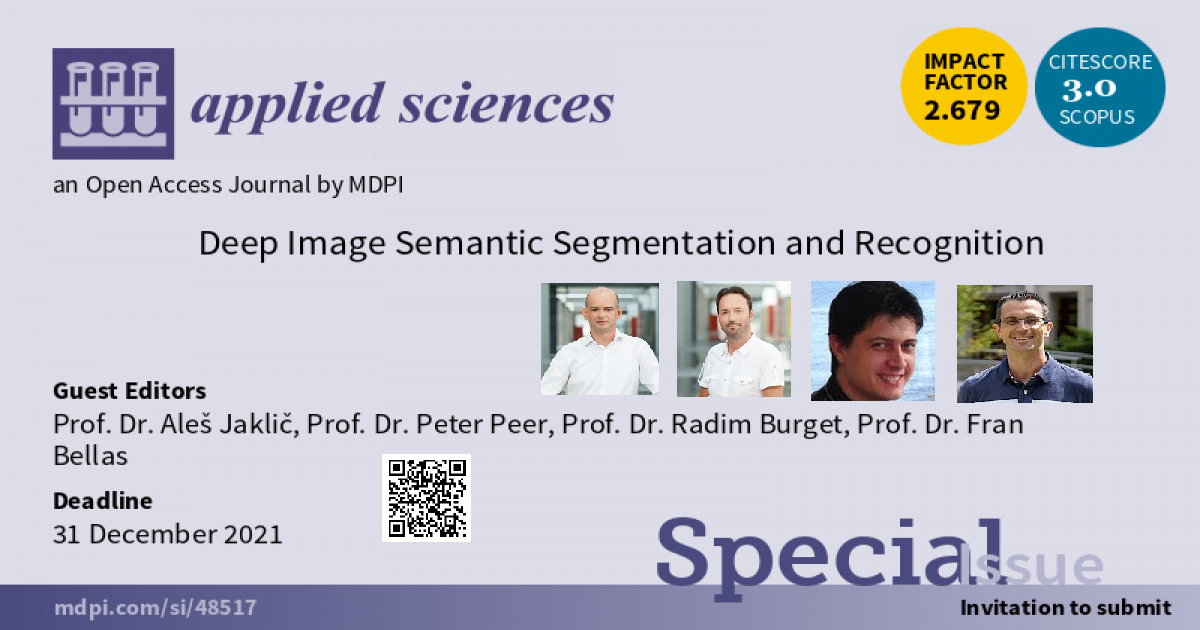Deep Image Semantic Segmentation and Recognition
A special issue of Applied Sciences (ISSN 2076-3417). This special issue belongs to the section "Computing and Artificial Intelligence".
Deadline for manuscript submissions: closed (31 December 2021) | Viewed by 45273

Special Issue Editors
Interests: computer vision
Interests: biometrics; computer vision
Interests: big data; deep learning; computer vision
Special Issue Information
Dear Colleagues,
Recent advances in hardware development and deep neural network architectures on top of the availability of big image databases spurred many new research directions in the field of computer vision, detection, segmentation, semantics extraction and recognition. Motivation for these research efforts stems from various practical applications ranging from autonomous driving to robotics in agriculture, from medical image analysis and biometrics to geosensing, and many more application areas that will benefit from significant improvement in performance of segmentation and recognition algorithms based on deep neural networks.
The aim of this special issue is to gather state of the art research to provide practitioners with broad overview of suitable deep neural network architectures and applications areas with objective performance metrices. We welcome well structured manuscripts with nicely illustrated background and novelty. We also recommend to authors to make the source code, databases, models and architectures publicly available, and to submit multimedia with each manuscript as it significantly increases the visibility and citations of publications.
Prof. Dr. Aleš Jaklič,
Prof. Dr. Peter Peer,
Prof. Dr. Radim Burget,
Prof. Dr. Fran Bellas
Guest Editors
Manuscript Submission Information
Manuscripts should be submitted online at www.mdpi.com by registering and logging in to this website. Once you are registered, click here to go to the submission form. Manuscripts can be submitted until the deadline. All submissions that pass pre-check are peer-reviewed. Accepted papers will be published continuously in the journal (as soon as accepted) and will be listed together on the special issue website. Research articles, review articles as well as short communications are invited. For planned papers, a title and short abstract (about 100 words) can be sent to the Editorial Office for announcement on this website.
Submitted manuscripts should not have been published previously, nor be under consideration for publication elsewhere (except conference proceedings papers). All manuscripts are thoroughly refereed through a single-blind peer-review process. A guide for authors and other relevant information for submission of manuscripts is available on the Instructions for Authors page. Applied Sciences is an international peer-reviewed open access semimonthly journal published by MDPI.
Please visit the Instructions for Authors page before submitting a manuscript. The Article Processing Charge (APC) for publication in this open access journal is 2400 CHF (Swiss Francs). Submitted papers should be well formatted and use good English. Authors may use MDPI's English editing service prior to publication or during author revisions.
Keywords
- computer vision
- deep learning
- detection
- segmentation
- recognition
- reconstruction
- grouping
- semantics
- verification
- identification
Benefits of Publishing in a Special Issue
- Ease of navigation: Grouping papers by topic helps scholars navigate broad scope journals more efficiently.
- Greater discoverability: Special Issues support the reach and impact of scientific research. Articles in Special Issues are more discoverable and cited more frequently.
- Expansion of research network: Special Issues facilitate connections among authors, fostering scientific collaborations.
- External promotion: Articles in Special Issues are often promoted through the journal's social media, increasing their visibility.
- e-Book format: Special Issues with more than 10 articles can be published as dedicated e-books, ensuring wide and rapid dissemination.
Further information on MDPI's Special Issue policies can be found here.








